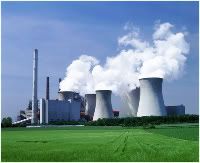Frontline on PBS: Nuclear Aftershocks
I hope everyone gets the opportunity to catch this episode of Frontline on PBS: Nuclear Aftershocks — one that essentially claims that nuclear energy is both unacceptably dangerous but completely necessary. I’m reminded of the way Amory Lovins begins his current-day presentations: “Which would you rather die from? Nuclear holocaust, drowning from rising sea levels, respiratory disease, or terrorist attacks and social chaos from the demand for increasingly scarce oil?” I have to admit; it’s a great way to capture an audience’s attention.
“Aftershocks” did a great deal to explore the dangers of nuclear energy, while presenting some semblance of the case for renewable energy. But the treatment of solar, wind, etc. in this one-hour show should have been longer, less simplistic, and less dominated by the nuclear industry and other groups with obvious vested interests in competitive technologies. We had to listen to a nuclear spokesperson trying to convince the audience: “(Renewables won’t be abundant and affordable) until I’m gone, you’re gone, and all our children are gone.” That’s simply false, you shameless pawn of an industry without morals.


I missed it, but was able to view the entire program via the Internet last night.
Although the program did have its good points, it was extremely unbalanced. Although the radiation released is a problem, it failed to put it into a perspective that made it understandable.
The program should not be used to justify the condemnation of nuclear power. Rather, it should be seen as a wake-up call to develop safer nuclear technologies and probably phase out some nuclear installations which are not safe. The Japanese reactors were of the boiling water type which, in my opinion, is less safe than the more common pressurized water thermal reactors which are mostly what we use here in the U.S. Also, as the PBS program pointed out, even in the early stages of construction or before, there were warnings that the design was inadequate to deal with the maximum size tsunami which could be expected. The design also was inadequate to deal with the hydrogen that was generated, the result being that damaging hydrogen explosions occurred.
I worked from 1984 to 1994 for a U.S. branch of a Japanese company. There are aspects of Japanese culture that make it difficult for the Japanese to correct mistakes, and certain aspects of the reactor design were a mistake. In general, in Japanese culture, a man who has his mistakes pointed out to him is highly embarrassed and feels that he has lost fact. That inhibits people from pointing out mistakes. We found that problem over and over again in software development. At meetings, which included Japanese nationals, we generally had to have an interpreter, even when everyone had an adequate command of English, because the Japanese greatly feared being embarrassed if they made a mistake in English grammar. Considering this, it should not be surprising that there were serious design errors in the damaged Japanese nuclear plants, the most serious of which was locating the Diesel back-up generators where they were certain to be damaged if a tsunami struck, even if the tsunami was less severe than others which had previously struck Japan.
In earlier times, the road accident rate caused by automobiles was way higher than would be tolerable today; people even broke arms cranking cars. But improved technology and safety regulations dramatically reduced the per mile death rate. Cars were not banned; instead, they were improved. There are many ways to design nuclear reactors and the designs we are using, while tolerably safe if properly managed, are not nearly so safe and economical as improved designs would be.
Rather than suffering the consequences of increasing our dependence on fossil fuels by spending hundreds of billions on an energy technology of questionable practicality, we should be doing more research and development to improve nuclear technology.